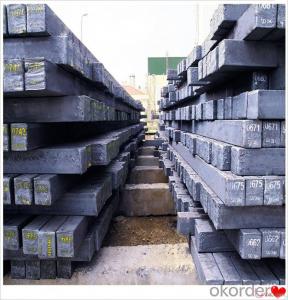Chrome Alloy Steel Q235,Q255,Q275,Q345,3SP,5SP,20MnSi Made in China
- Loading Port:
- China main port
- Payment Terms:
- TT OR LC
- Min Order Qty:
- 20 m.t.
- Supply Capability:
- 200000 m.t./month
OKorder Service Pledge
OKorder Financial Service
You Might Also Like
Chrome Alloy Steel Q235,Q255,Q275,Q345,3SP,5SP,20MnSi Made in China
Specification
Steel billet(ingot) by cogging or breakdown of semi-finished products, is the raw material of all kinds of steel mill. Billet section of square, round, flat, rectangular and abnormity of several kinds of, mainly related to the shape of rolled products.
CNBM Q235,Q275,Q345,3SP,5SP,20MnSi Billets Steel
Hot Rolled Steel Billets/ Mild Steel Bar/ Billet Steel
Specification (see below)
Standard: GB/JIS/ASTM
Size: 50*50mm-180*180mm
Length: 3-12mtrs or Customised
Steel material: Q235,Q255,Q275,Q345,3SP,5SP,20MnSi
Technique: Hot rolled
FOB Unit Ton Price $250-350 and Usually I will quote you CFR price.
MOQ: Usually 1000-10000MT/size
Shipment:By Container,Bulk Vessel
Packaging Details: bundles with steel strips or as customers's requirements
Delivery time: Usually within 30 days after the deposit/LC
Inspection:Third party inspection before loading.
Technical data
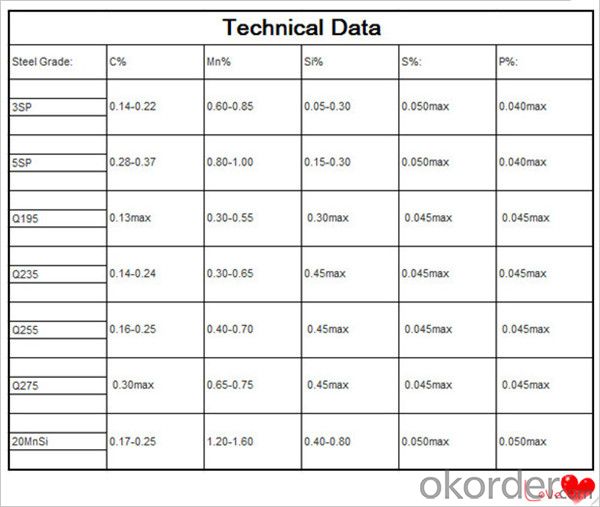
Feature Steel Billet
Rectangular billet continuous casting billet and mainly general carbon steel, low carbon low silicon cold-rolled material, high quality carbon structural steel, high strength low alloy steel, special steel, etc.
The billet is mainly divided into two kinds from the shape:
Slab: cross section width and height of the ratio of the larger, mainly used for rolling plate.
Billet: equal cross section width and height, or a huge difference, mainly used for rolling steel, wire rod. ,
Steel billets have distinct characteristics as compared with already furnished steel bars and products. Billets have a specific grain structure, which enables the metal to be processed more intricately. Steel billets are also known for their malleability and ductility, especially when exposed to varying temperatures during shaping and molding.
Packaging & Shipping
1. Packaging:
1) Small size: in bundles
2)Big size: in bulk
3)in plastic packing or as per customer requirement
2. Delivery time:
1) Normal size: within 7days send from warehouse directly
2) Special size: with 25-30days customer made for you
3. Trade terms:FOB/CFR/CIF
4. Shippment:
1) length:≤5.8m loaded in 20FT Container with 25-27tons
2) length:≤11.8m loaded in 40FT Container with 25-27tons
3) lengnth:≥12m shipped by bulk vessel, FILO terms
Steel Billet Images
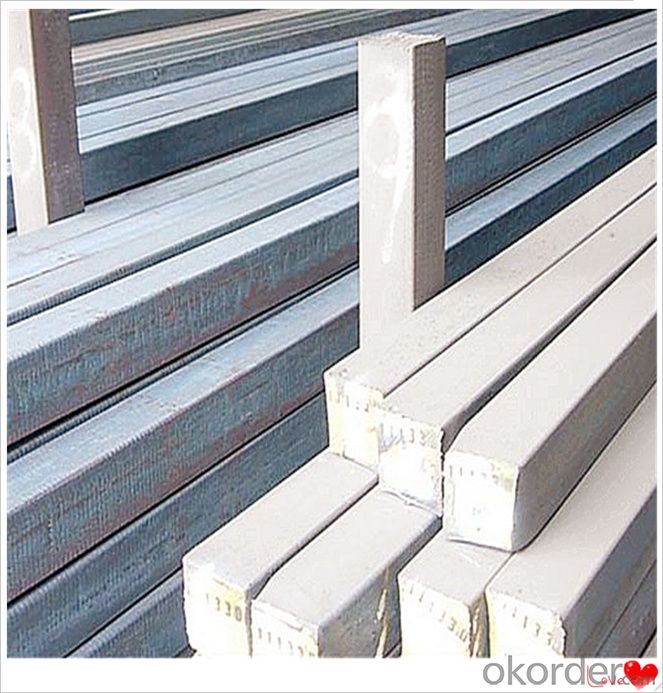
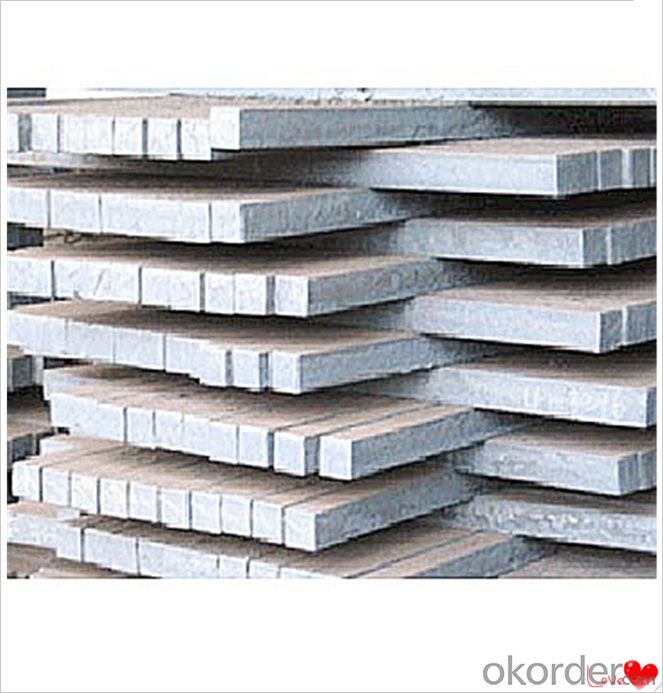
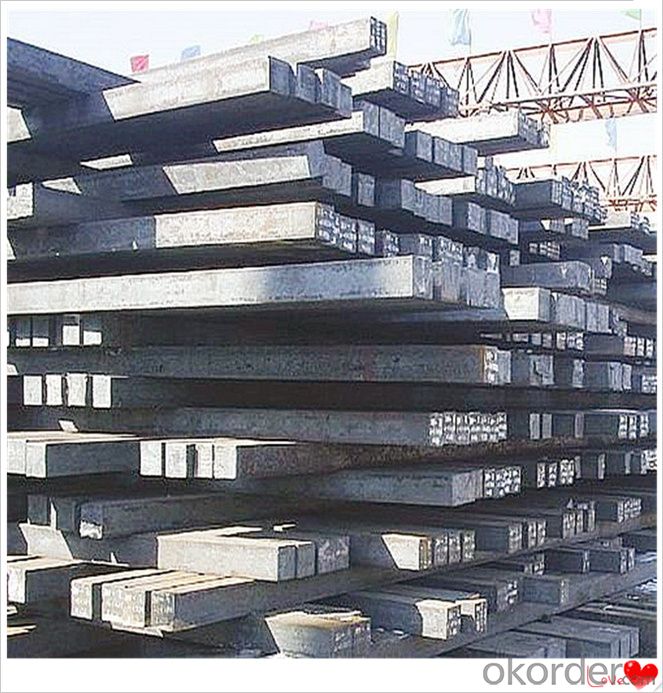

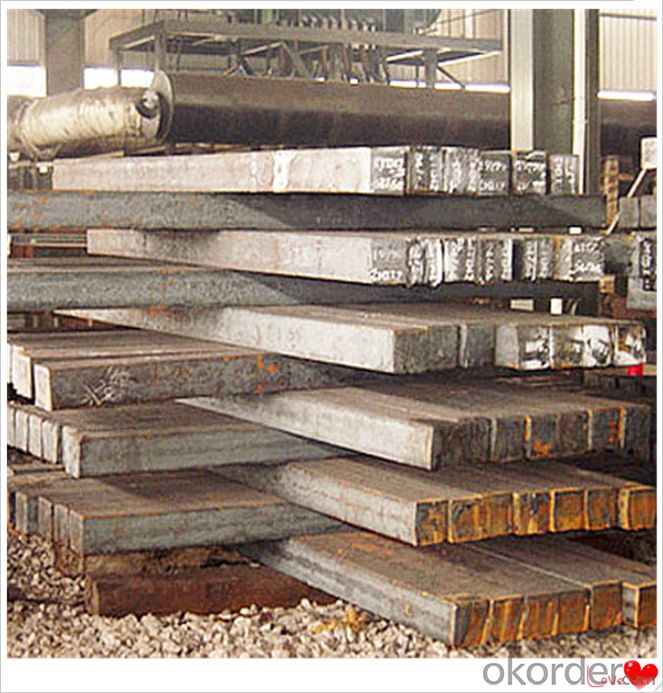
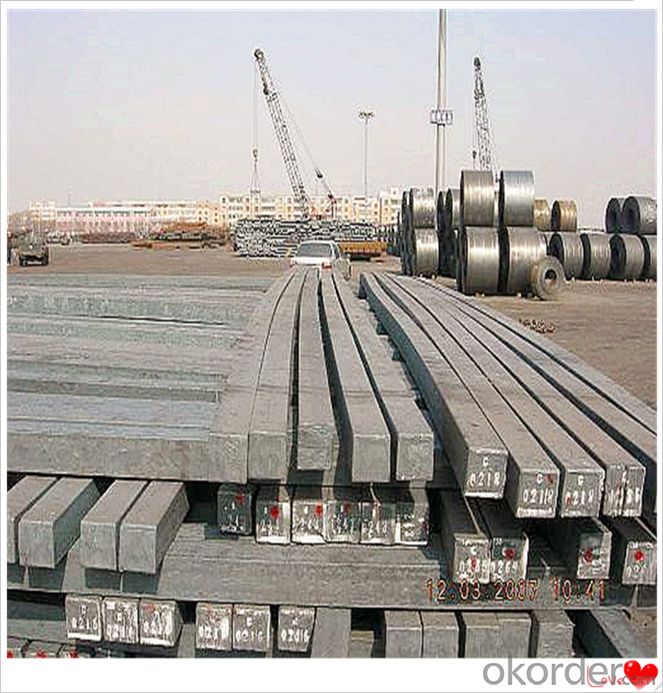
Processing
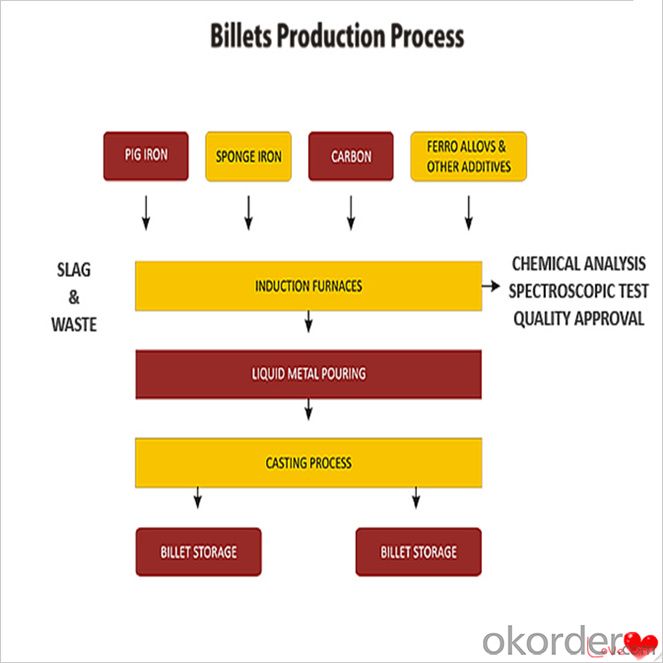
Usage-Billet Steel
Used for the plant, the bridge,shipment building high-rise building construction,lifting and transportation machinery, equipment manufracturing base building the support foundation pile manufacturing.
Billets, or ingots (as they sometimes referred to), are not of practical use until they have been formed into more functional shapes and sizes. While they have already been put in the furnace, they still require a series of shaping and molding procedures such as hot and cold working, milling and cutting before they are sold in hardware stores, or used for different applications. The unformed billets, however, can be used in striking currency such as coins and as reserves, similar to gold bars.
FAQ-Billet Steel
We have organized several common questions for our clients,may help you sincerely:
1) How about your company?
A world class manufacturer & supplier of castings forging in carbon steel and alloy steel,is one of the large-scale professional investment casting production bases in China,consisting of both casting foundry forging and machining factory. Annually more than 8000 tons Precision casting and forging parts are exported to markets in Europe,America and Japan. OEM casting and forging service available according to customer’s requirements.
2) How to guarantee the quality of the products?
We have established the international advanced quality management system,every link from raw material to final product we have strict quality test;We resolutely put an end to unqualified products flowing into the market. At the same time, we will provide necessary follow-up service assurance.
3) How long can we receive the product after purchase?
In the purchase of product within three working days, We will arrange the factory delivery as soon as possible. The pecific time of receiving is related to the state and position of customers.Commonly 7 to 10 working days can be served.
4)Do you have your own QC department?
Yes, we have, our QC department will inspect the goods during the process of mass production and after completion of production.
hot sale!!! Cast Steel Grades/ mild steel bar/ billet steel
(1): High quality steel with reasonable price.
(2): Wide excellent experiences with after-sale service.
(3): Every process will be checked by responsible QC which insures every product's quality.
(4): Professional packing teams which keep every packing safely.
(5): Trial order can be done in one week.
(6): Samples can be provided as your requirements.
- Q:How is the quality of steel billets ensured during the manufacturing process?
- The quality of steel billets is guaranteed by implementing strict testing measures and adhering to industry standards throughout the manufacturing process. There are several crucial steps involved in maintaining the quality of steel billets: 1. Inspection of Raw Materials: Initially, the raw materials, typically iron ore and/or scrap metal, undergo careful scrutiny to ensure they meet the necessary specifications. This involves examining impurities and verifying the chemical composition. 2. Melting and Refining: The raw materials are melted in a furnace and impurities are eliminated through refining techniques like desulphurization and degassing. This process improves the quality of the steel by reducing unwanted elements and enhancing its overall purity. 3. Casting: Subsequently, the refined steel is cast into billet form using a continuous casting process. This method guarantees uniform size and shape of the billets, which is crucial for further processing. 4. Non-Destructive Testing: Throughout and after the continuous casting process, various non-destructive testing methods, including ultrasonic testing, magnetic particle inspection, and visual inspection, are employed to assess the integrity of the billets. These tests identify any defects or imperfections that may compromise the quality of the billets. 5. Heat Treatment: Depending on the desired properties of the final steel product, the billets may undergo heat treatment processes like annealing, quenching, or tempering. These procedures further enhance the strength, hardness, and other mechanical properties of the steel. 6. Final Inspection: The finished steel billets undergo a final inspection to ensure they meet the required specifications. This involves assessing their dimensions, surface quality, and mechanical properties. Typically, samples from each batch are subjected to destructive testing to confirm their strength and other properties. 7. Traceability and Documentation: It is essential to maintain proper traceability and documentation of all quality-related activities throughout the manufacturing process. This includes recording test results, maintaining batch records, and ensuring accurate identification and labeling of the billets. By adhering to these rigorous procedures and conducting various tests, manufacturers can guarantee the maintenance of steel billet quality at every stage of the manufacturing process. This ensures that the final steel products made from these billets will meet the required standards and perform as intended in various applications.
- Q:What industries use steel billets?
- Due to their strength, durability, and versatility, steel billets are extensively used in a wide range of industries. The construction industry heavily relies on steel billets for the production of structural components like beams, columns, and girders, which provide vital support and strength in infrastructure projects such as buildings and bridges. In the automotive industry, steel billets are crucial for manufacturing various car parts, including engine components, chassis, and suspension systems. The preference for steel billets in this industry stems from their high strength-to-weight ratio, which enhances fuel efficiency and overall performance. Manufacturing industries like machinery, equipment, and tool production also heavily depend on steel billets. These billets are used to manufacture critical components such as gears, shafts, valves, which require exceptional strength, durability, and precision. Additionally, steel billets play a vital role in the energy sector, particularly in the production of oil and gas pipelines. These pipelines require specific grades of steel billets that can withstand harsh conditions, high pressures, and corrosive environments. Moreover, steel billets have applications in other sectors such as shipbuilding, aerospace, mining, and agriculture. They are widely utilized in any industry where strength, durability, and reliability are paramount. In conclusion, the remarkable mechanical properties of steel billets enable their diverse applications across multiple industries. The demand for steel billets remains strong as they are an indispensable raw material for producing critical components in numerous sectors.
- Q:What are the main uses of steel billets in the automotive industry?
- Various applications in the automotive industry make steel billets widely used. One of their primary uses involves the production of forged components, such as crankshafts, connecting rods, and camshafts. These components demand high strength and durability, qualities that steel billets possess and meet these requirements. Gears, axles, and transmission shafts also rely on steel billets for their manufacturing. These parts must withstand heavy loads and ensure smooth and efficient power transmission within the vehicle. Steel billets possess excellent mechanical properties, including high tensile strength and toughness, which make them the ideal choice for such applications. Furthermore, suspension components like control arms, steering knuckles, and suspension links depend on steel billets. These components play a crucial role in maintaining vehicle stability, control, and comfort. Steel billets are preferred for these parts due to their exceptional strength, stiffness, and impact resistance. Moreover, body and chassis components, such as pillars, beams, frames, and reinforcements, benefit from the use of steel billets. These components provide structural integrity and crash protection to the vehicle. Steel billets offer a superior strength-to-weight ratio, corrosion resistance, and formability, making them a popular choice for these safety-critical components. In conclusion, steel billets find applications in the automotive industry for forged components, gears and transmission parts, suspension components, and body and chassis components. Their exceptional mechanical properties are indispensable for building durable, reliable, and safe vehicles.
- Q:How are steel billets heat-treated?
- Steel billets undergo heat treatment through either annealing or quenching and tempering processes. In annealing, the steel billets are heated to a specific temperature and gradually cooled, which relieves internal stresses and enhances the steel's ductility and toughness. Conversely, quenching and tempering involves heating the billets to a high temperature and quickly cooling them in a quenching medium, such as water or oil. This rapid cooling creates a hard and brittle structure in the steel, which is then tempered by reheating the billets to a lower temperature. This tempering process reduces brittleness and increases toughness. The choice of heat treatment process depends on the desired properties and applications of the steel billets.
- Q:How are steel billets used in the production of industrial boilers?
- Steel billets are an essential component in the production of industrial boilers. These billets, which are typically made of high-quality steel, serve as the raw material for fabricating the various parts and components of a boiler. The manufacturing process starts with the steel billets being heated to a specific temperature, which allows them to be easily shaped and formed. They are then passed through a series of rolling mills, where they are transformed into different shapes and sizes, such as plates, bars, or tubes, depending on the specific requirements of the boiler design. These billets are then further processed to create the necessary boiler components. For example, plates are cut and shaped to form the boiler shell, which serves as the main structure of the boiler. Bars are used to create the boiler tubes, which are responsible for transferring heat from the combustion chamber to the water. Additionally, other parts such as flanges, fittings, and supports are also made from steel billets. The quality and strength of the steel billets used in the production of industrial boilers are crucial factors in ensuring the durability and efficiency of the final product. Steel billets with high tensile strength and excellent heat resistance properties are preferred, as they can withstand the high pressures and temperatures associated with boiler operations. In summary, steel billets play a critical role in the production of industrial boilers by providing the raw material necessary for fabricating the various components. Their versatility, strength, and durability make them an ideal choice for creating the robust and reliable boilers required for a wide range of industrial applications.
- Q:What are the different surface treatment methods used for steel billets?
- Steel billets undergo various surface treatment methods to enhance their properties and optimize their performance. Some commonly employed techniques include: 1. Pickling: By immersing steel billets in an acid bath, typically hydrochloric or sulfuric acid, any scale or oxides on the surface are effectively removed. This method improves surface finish and prepares billets for subsequent processing. 2. Shot blasting: High-velocity steel shots are used to subject steel billets to remove rust, scale, or contaminants from the surface. This method not only cleans the surface but also enhances its roughness, facilitating better adhesion of coatings or paints. 3. Phosphating: Applying a phosphate coating chemically onto the surface of steel billets is known as phosphating. This coating provides corrosion resistance and enhances paint adhesion. Phosphating is commonly employed as a pre-treatment method before applying organic coatings. 4. Galvanizing: A widely-used surface treatment method involves coating steel billets with a layer of zinc, known as galvanizing. This process ensures excellent corrosion resistance and safeguards the steel against environmental factors. Galvanized steel billets find extensive use in outdoor applications and industries where rust prevention is crucial. 5. Electroplating: Electroplating involves depositing a thin layer of metal, such as chromium or nickel, onto the surface of steel billets using an electric current. This method enhances aesthetic appearance, corrosion resistance, and wear resistance of the steel billets. 6. Coating: To provide a protective layer on the surface of steel billets, coating techniques such as painting, varnishing, or applying protective coatings are utilized. These coatings act as a barrier against corrosion, abrasion, and other forms of damage. Coatings can be applied using methods like spraying, dipping, or powder coating. 7. Passivation: Passivation is a chemical process employed to eliminate free iron and other contaminants from the surface of steel billets. This process aids in restoring the steel's passive film, which enhances corrosion resistance. Passivation is commonly employed in stainless steel billets to augment their resistance to rust and corrosion. These surface treatment methods significantly contribute to improving the quality, durability, and performance of steel billets, rendering them suitable for diverse applications across industries such as construction, automotive, and manufacturing.
- Q:What are the international standards for steel billets?
- The international standards for steel billets are defined by organizations such as the International Organization for Standardization (ISO) and the American Society for Testing and Materials (ASTM). These standards typically encompass various aspects including chemical composition, mechanical properties, dimensions, tolerances, and surface quality, ensuring consistency and quality across different countries and manufacturers.
- Q:Can steel billets be painted or coated for decorative purposes?
- Yes, steel billets can be painted or coated for decorative purposes. Painting or coating steel billets not only enhances their appearance but also provides protection against corrosion and other environmental factors. Various types of paints and coatings can be used, such as epoxy, powder coating, or metallic finishes, to achieve the desired decorative effect. These coatings can be applied to steel billets through processes like spray painting, electrostatic coating, or hot-dipping. It is important to properly prepare the surface of the steel billets before applying the paint or coating to ensure good adhesion and longevity of the decorative finish.
- Q:How do steel billets compare to other types of raw materials in manufacturing?
- Steel billets, recognized extensively as one of the most versatile and commonly utilized raw materials in manufacturing industries, possess various advantages that render them highly sought after. To begin with, the extraordinary strength and durability of steel billets make them suitable for a diverse array of applications, such as construction, automotive, and machinery manufacturing. Boasting high tensile strength, steel billets ensure the structural integrity of the final product. Furthermore, steel billets exhibit exceptional heat resistance, making them ideal for sectors involving exposure to extreme temperatures, such as aerospace and energy industries. These billets can endure high temperatures without compromising their mechanical properties, guaranteeing the longevity and reliability of the manufactured goods. Additionally, steel billets possess high malleability and can be effortlessly shaped into numerous forms through processes like rolling, forging, or extrusion. This versatility enables manufacturers to fabricate intricate and complex parts, components, and structures, catering to the diverse needs of various industries. Moreover, steel billets are readily available in substantial quantities, making them a cost-effective option for manufacturing. The abundance of steel billets in the market ensures a stable supply chain, mitigating potential disruptions caused by material shortages. Lastly, steel billets are renowned for their recyclability, rendering them an environmentally friendly choice. Steel stands as one of the most recycled materials globally, and the utilization of steel billets in manufacturing contributes to reducing the environmental impact of waste disposal, while conserving natural resources. In conclusion, the exceptional strength, heat resistance, malleability, cost-effectiveness, and recyclability of steel billets surpass other types of raw materials in manufacturing. These qualities establish steel billets as the preferred choice for a wide range of industries, offering reliability, versatility, and sustainability throughout the manufacturing process.
- Q:How do steel billets contribute to the overall strength of a structure?
- The overall strength of a structure is greatly influenced by steel billets, which serve as essential building blocks. These billets, in their semi-finished form, are utilized as raw materials for producing various structural components. The exceptional strength and durability of steel itself are the primary reasons why steel billets enhance the strength of a structure. This makes steel an ideal construction material. When steel billets are incorporated in the manufacturing process, they lay a solid foundation for creating stronger structural elements. Steel billets are typically shaped into different structural components, like beams, columns, and plates, through hot-rolling or forging. This manufacturing process subjects the steel to high temperatures and pressure, leading to a refined grain structure. The refined grain structure significantly improves the strength and toughness of the steel, making it more resistant to deformation and structural failure. Moreover, steel billets can be further processed to achieve specific mechanical properties required for different structural applications. For instance, heat treatment processes like quenching and tempering can enhance their hardness and toughness. Consequently, the steel can endure higher loads and stresses, thereby contributing to the overall strength and stability of the structure. Apart from their inherent strength, steel billets offer advantages in terms of versatility and design flexibility. They can be easily shaped into various sizes and dimensions, enabling engineers to create intricate structural configurations. This versatility allows for the optimization of the structural design, ensuring maximum load-bearing capacity and overall strength of the structure. Furthermore, steel billets possess excellent weldability, allowing them to seamlessly join with other steel components. This ensures the integrity and continuity of the structure, preventing weak points or potential failure zones. By creating a unified and interconnected system, the steel billets contribute to the overall strength and stability of the structure. In conclusion, steel billets significantly contribute to the overall strength of a structure through their inherent strength, refined grain structure, and ability to undergo various heat treatment processes. They provide a strong foundation for manufacturing structural components, enabling them to withstand high loads and stresses. The versatility and design flexibility of steel billets further optimize the structural design, while their excellent weldability ensures the integrity of the structure. As a result, steel billets are essential in constructing resilient and long-lasting structures.
1. Manufacturer Overview |
|
|---|---|
| Location | |
| Year Established | |
| Annual Output Value | |
| Main Markets | |
| Company Certifications | |
2. Manufacturer Certificates |
|
|---|---|
| a) Certification Name | |
| Range | |
| Reference | |
| Validity Period | |
3. Manufacturer Capability |
|
|---|---|
| a)Trade Capacity | |
| Nearest Port | |
| Export Percentage | |
| No.of Employees in Trade Department | |
| Language Spoken: | |
| b)Factory Information | |
| Factory Size: | |
| No. of Production Lines | |
| Contract Manufacturing | |
| Product Price Range | |
Send your message to us
Chrome Alloy Steel Q235,Q255,Q275,Q345,3SP,5SP,20MnSi Made in China
- Loading Port:
- China main port
- Payment Terms:
- TT OR LC
- Min Order Qty:
- 20 m.t.
- Supply Capability:
- 200000 m.t./month
OKorder Service Pledge
OKorder Financial Service
Similar products
New products
Hot products
Hot Searches
Related keywords
